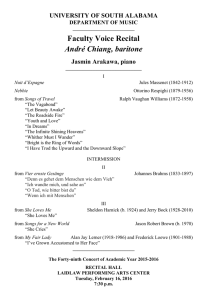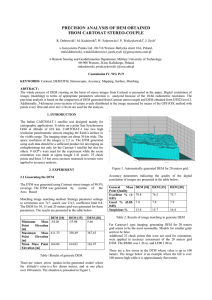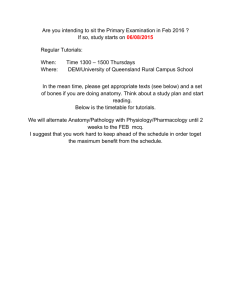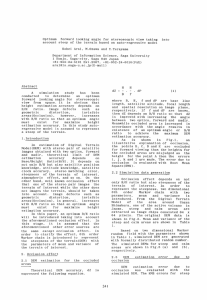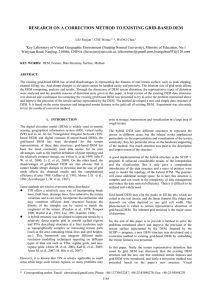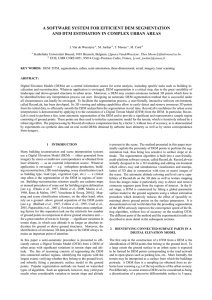14th Congress of the International ... Hamburg 1980 Commission IV Working group 1
advertisement
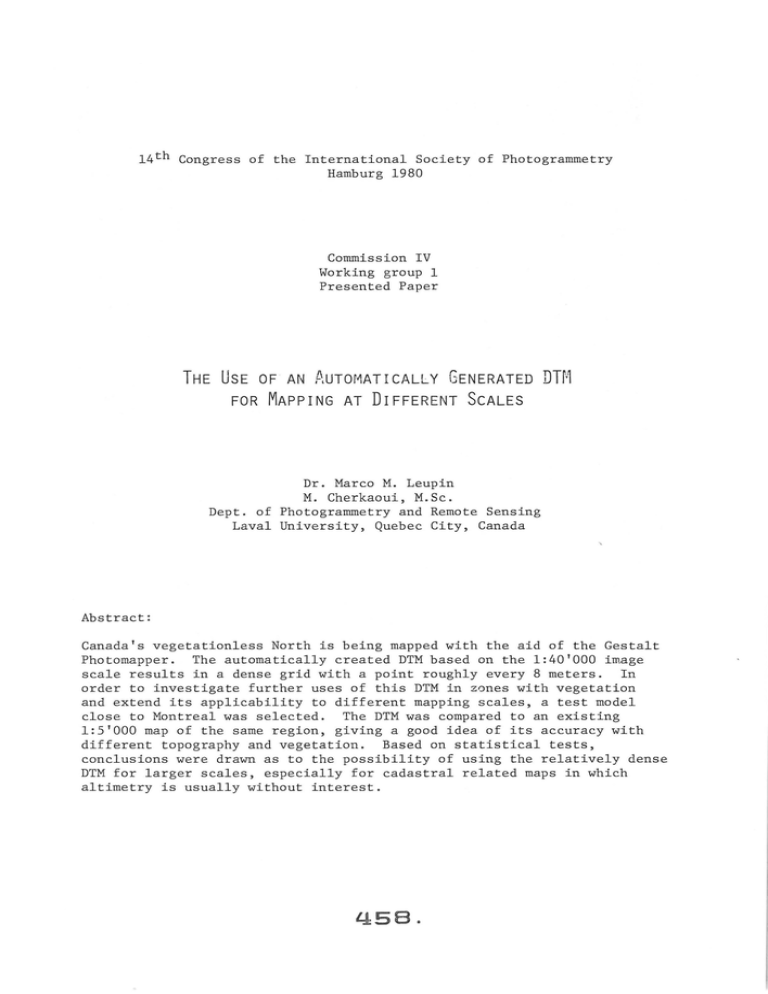
14th Congress of the International Society of Photogrammetry
Hamburg 1980
Commission IV
Working group 1
Presented Paper
THE UsE OF AN AuTOMATICAL LY GENERATED DTM
FOR MAPPING AT DIFFERENT ScALES
Dr . Marco M. Leupin
M. Cherkaoui , M. Sc .
Dept . of Photogrammetry and Remote Sensing
Laval University, Quebec City, Canada
Abstract :
Canada's vegetationless North is being mapped with the aid of the Gestalt
Photomapper . The automatically created DTM based on the 1:40'000 image
scale results in a dense grid with a point roughly every 8 meters . In
order to investigate further uses of this DTM in zones with vegetation
and extend its applicability to different mapping scales , a test model
close to Montreal was selected . The DTM was compared to an existing
1 : 5 ' 000 map of the same region, giving a good idea of its accuracy with
different topography and vegetation . Based on statistical tests ,
conclusions were drawn as to the possibility of using the relatively dense
DTM for larger scales, especially for cadastral related maps in which
altimetry is usuall y without interest .
q se.
THE UsE oF AN AuToMATICALLY GENERATED DTM
FOR MAPPING AT DIFFERENT ScALES
1.
Introduction
Digital terrain models (DTM) or - more specifically - digital elevation
models (DEM) are used more and more in map production and other
applications. At the same time, land-information systems and data
banks are propagated . However, such systems are always established
in view of a particular application, be it topographical, cadastral,
utilitary or other. Moreover, the data are collected in accordance
with a certain accuracy related to the scale of the final graphical
product.
This is a significant constraint and it is contr~ry to the basic scope
of land-information systems. Unfortunately, there is not very much
one can do about it, since nobody collecting data for a topographical
1:50'000 map will do it with the same accuracy and density in order to
satisfy a 1:1'000 cadastral map. More likely, the reverse situation
can be treated with modern computer technology, involving rather
extensive filtering procedures .
On the other hand, many cartographic applications do not need the
accuracy of topographical maps (e.g. thematic and ressource maps) or
do not need altimetry (cadastral maps) .
With the use of the Gestalt Photomapper, GPM-2, Canada'a,
vegetationless, northern regions are presently mapped at 1:50'000 .
The Photomapper produces a dense DEM (a point every 7 m) grid based
on 1 : 40'000 photographs . This grid has served as a reference in the
present research, in which accuracy and potential applications are
studied .
2.
Test area
The Topographical Survey Branch of the Ministry of Energy, Mines and
Ressources placed two 1:40'000 test models, close to Montreal's new
Mirabel airport, at our disposal . The area was chosen because of its
variety in topography and vegetation (flat and hilly terrain, clear
areas and forests) . In addition to that, the area is covered with a
1:5'000 map with 2m contour lines derived from 1:15'000 photography .
This material was to be used as accuracy standard for the various
tests. A specific and characteristic zone was picked out for detailed
studies . This zone is covered by 1 model at 1:40'000 and 1 model at
1 : 15'000.
459.
covere.d area
flat terrain
..
,
Figure l: The ~~\BEL test area
Selected test zones
3.
Data description
The original D. E .M. was produced on the gestalt Photomapper GPM-2 at
the Topographical Branch . The GPM-2 has widely been described recently
and there is no need to reiterate its features (see e .g. /2/) . The
DEM, gained through automated correlation based on the 1 : 40 ' 000
photography , has a grid density of roughly every 7 . 0 m a point . The
mask chosen on the GPM-2 was ff 2 (mean value) which, under practical
conditions, would have been the selected value to represent the
topographical situation of the area . The total of 620'000 points seems
sufficient to conduct this kind of investigation.
patch 2
1024 points
patch l
32 x 32 points
1 02 4 points
For the reader not familiar with the
DEM structure produced by the GPM- 2, it
may be reminded that the DEM is
arranged in groups, production units
ralled "patches". One patch (in our
case with ff 2 mark) measures 5 . 82 mm x
5.82 mm and contains 32 times 32
elevations, giving 1024 points per
patch (see Fig . 2) .
patch 2n -1
1024 points
patch 2n
pdtch 2n
l
1024 points
Figure 2 : Arrangement of DEM patches with
the GPM-2
li60.
In order to be able to compare these values to the existing map, they
have been transformed into the UTM system and marked on a 1:5'000
Cronaflex sheet. This has been done with the help of a high-precision
Haag-Streit coordinatograph which claims to have a point accuracy of
± 0.03 mm.
Using all of the 620'000 points would have been a
formidable task and consequently 400 points were picked out by skipping
the remaining points, but still forming a regular grid. The mapping
scale was 1:5'000 .
After a careful relative and absolute orientation of the 1:15'000 model
on a A7, the spotheights of all 400 points were plotted. The values of
the spot heights obtained through the GPM-2 with 1:40'000 photography
and the spot heights obtained on the A7 with 1:15'000 photography form
the basic data set to be investigated.
4.
Accuracy of the basic data
The following tables give an idea of the model accuracy for 1:40'000
and 1:15'000 as obtained through a spatial transformation (absolute
orientation) .
Controlpoint
Vv (m)
Vv (m)
Vz (m)
509
0.20
- 1 .84
0.28
511
2.25
0.24
0.92
416
- 1.51
0.90
- 0.54
- 0.75
0.68
0.19
0.65
0.38
- 2.37
- 1.54
- 0.96
1.01
414
510
415
I
I
I
OX
Table 1:
= ± 1. 47
0y = ± 1. 07
Absolute orientation, model 1:40'000
(GPM-2 results)
l.J:61.
02
= ± 1.25
--
Controlpoint
V" (m)
V" (m)
85096
- 0 . 05
0.18
- 0.80
85106
0.21
0 . 30
- 0 . 50
75146
0 . 05
0.17
0 . 16
7515 6
0.09
0.03
0.10
85116
- 0 . 28
- 0.43
- 0.70
75166
0.07
0 . 00
0.15
75176
0 .13
- 0.05
0 .13
83097
0 . 03
0.14
0.15
83107
0 . 00
0 . 24
- 0 . 13
ox = ± 0.14 m
Oy = ± 0.23 m
Table 2 :
v7
Oz
(m)
= ± 0 . 43 m
Absolute orientation, model 1 : 15'000
(A7 results)
All the selected 400 grid points which have been measured on the
1:15'0 00 model have been transformed numerically in the UTM system.
The measured Z coordinate minus the GPM-2 Z coordinate for the same
point represent the listed ~Z.
A first glance at the table 3 shows irnrnediatly that these must be a
systernrnatic effect in the ~Z, due to a large overrepresentation of
positive values. This was to be expected,
~z
m
200
Frequency
r-
- 10
8
- 6
- 4
- 2
0
2
4
6
8
10
12
14
16
Table 3 :
1
1
1
6
46
91
64
45
31
30
32
23
18
14
-
r-
rr-
100
r-
r-
n--r-,_,
Figure 3: Cumulative f requency distribution
Frequency distribution of the
462.
~Z.
as all zones covered with forest must more or less show a 6Z in the
magnitude of the height of the trees.
Moreover, the three largest negative values seem to indicate some sort
of blunder . A closer investigation showed that all three points were
on a topographical break line (river) and that a small difference in
the planimetric position could easily lead to such differences .
5.
Elimination of the "tree effect"
Comparing the two DEMS in forest areas showed a regular 6Z difference
in the order of a mean tree height .
It seems that in such areas the
GPM-2 treats the tree-surface as correlation ground and (assuming a
relatively dense and uniform tree population as often encountered in
Canada) does it with consistency .
In order to evaluate the quality of the DEM in forest areas , all points
of the test grid falling in such areas were picked out and underwent
separate treatment . Moreover, different profiles were selected to help
determine the Z shift due to the trees. Figure 4 shows the procedure .
z
• GPM-2
L---------------------------------
X
Figure 4: Determination of the tree hei ght
zi" ao+alxi (linel)
Zj_= a~ +a 1Xj_
(line 2)
In all profiles, a line representing the terrain slope was found
through least squares .
a~Xi
zi =
R0
+
+ Vi for A7 profiles .
Zj_ =
ao
+ a1Vi + Vi for GPM- 2 profiles .
al, the slope , being the same in the two profiles .
The evaluation of different profiles is different zones yielded more
or less identical results . With the now known coefficients, the ground
elevations of the GPM-2 points can be found as
Figures 5 , 6 and 7 show the result of this correction procedure . While
in Fig . 5 we have the absolute frequencies of all the 403 points before
'~ 63.
the correction (the values listed in table 3), figure 6 shows the
corrected result, with the cumulative frequencies in Figure 7.
100
100
\
'I
,.....
'
I
f-
I
I
i
i
I
50
50
I-
r-
,.....
,,
,l
~-:T
.. .
I
I
II
....
' ..
r..,
t
'
I
\
'
~
'
'
I-
'{b
Figure 5: Absolute frequenc_ distribution
before the correction
Figure 6: Absolute frequency distr.
after "tree-correction"
200
.-r-r-
.....
r-t-1-
1-
100
t-
.-
Figure 7: Cumulative frequency distrafter correction
6.
Representative areas
In order to get an idea of the accuracy under different conditions,
the test area was subdivided into 6 characteristic zones (see Figure 1).
All these zones are represented by typical profiles. The results, with
and without corrections, are given in Figures 8 to 13.
Z(m)
Z(m)
70
6
A
A7
6
e GPM-2
230
::-----::..;:::----~::.-------X( m)
230
A
Figure 9 : Semi-covered area, flat terrain
A7
• GPM-2
f
• GPM- 2 corrected
-------·--............,.,............____
70
460
"::-:-------~~------~~------------- X(m)
Figure 8: Uncovered area, flat terrain
Z(m)
• A7
e GPM-2
460
----...--------·
:65
65 _ _ ...._
... A7
e GPM-2
Figure ll : Uncovered area, semi-rough terrain
Figure 10: Covered area, flat terrain
.
(m)
Z(m)
• A7 point
e GPM-2 point
• corrected GPM-2 point
150
.............. _____
,,
....
--
'~- .... .............
.............
..........
.......
1 30
140
Figure 12: Covered area, semi-rough terrain
A
•
•
A7
GPM-2
GPM-2 corrected
230
460
Figure 13: Covered area, rough terrain
After applying the "tree correction", all the 1:1Z were submitted to a
goodness of fit test, which should help to detect remaining systematic
effects. The result was negative, showing no sign of systematic 1:1Z.
lJ:65.
7.
Application to different scales
Far from
produced
1 : 50'000
obtained
canadian
being exhaustive, the study prov e s neve rthele s · that the D S~ ,
on the GPM-2 at a 1 : 40 ' 000 photo scale for the sole use of the
topographical map of Canada can be of wider use . The results
in the Mirabel test area, which represents a typical southern
topography and vegetation, are extremly encouraging .
An automatic procedure has to be found which detects forest areas on
the image .
In this areas the "tree correction" can be applied based
on statistical data on mean tree heights . The resulting DEM can be
used to produce maps at larger scales than 1 : 50 ' 000 .
To investigate this possibility, contour-lines were produced based on
the corrected GPM-2 DEM and chosing the extreme mapping scale of
1 : 5'000 . These contours were compared to the existing 1 : 5 ' 000 map,
which was produced observing the Quebec prov i ncial tolerances for maps :
1 : 5'000
a planimetric = ± 1 m
a altimetric = ± 0 . 45 m
for control points on the
map
and 50% tolerance of the contour interval (in our case ± 1 m) for
contour lines , 25 % (± 0 . 50 m) for spotted points .
In most parts of the test area, the coincidence of the contour lines
is suff i cient to satisfy the above mentioned tolerances . This is a
very good result keeping in mind the 1 : 8 photo-map ratio.
It is due
partially to the extreme density of the DEM, which seems to drastically
improve the overall accuracy .
8.
Conclusions
Despite the drawbacks of automatically correlated DEM ' S in areas with
vegetation and artific i al features, the comparison with existing maps
are highly satisfactory . This is achieved by correcting the DEM for
the "vegetation effect" (in p ractical terms the tree height) by
subtracting a constant Z value . The fact that the GPM-2 produces an
extremly dense DEM is an other factor that improved substantially the
overall accuracy .
The DEM based on 1:40 ' 000 photography is accurate enough to satisfy
1 : 20 ' 000 map tolerances for topographical use . For other applications
with less severe requirements i n altimetric accuracy, larger scales
can be produced .
The potential of a dense DEM, which in the not too distant future will
cover the entire Canadian territory, looks extremly powerful and there
is nothing limiting future applications in a wide range of cartographic
domains .
Acknoledgements : The authors gratefully acknoledge the moral
assistance o.f Dr . Z . M. Zarzycki , Director , Topographical Survey , EMR ,
and the constant help and guidance of Dr . M. Allam , Head , Research and
Developpement, EMR, Ottawa .
LJ:66.
References
/1/
M. Allam.
DTM Application in Topographic Mapping Photogrammetric
Engineering and Remote Sensing, p. 1513-1520, December
1978.
/2/
R.E. Kelly
P.R.H. Me Connell
S.J. Mildenberger.
/3/
J.M. Zarzycki.
The Gestalt Photomapping System.
Photogrammetric Engineering and Remote Sensing,
page 1407-1417, November 1977.
An Integrated Digital Mapping System.
The Canadian Surveyor, p. 443-452, December 1978.



